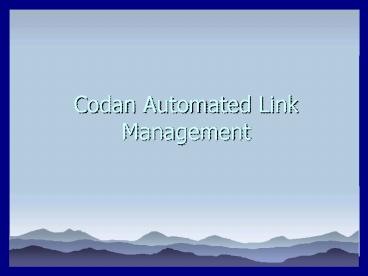Codan Automated Link Management PowerPoint PPT Presentation
1 / 25
Title: Codan Automated Link Management
1
Codan Automated Link Management
2
Introduction
- Goals
- Design
- Simulation
- Observations
- Conclusion
3
Goals
- Protocol compatibility
- Automate links for untrained operators
- Minimise soundings and on-air time
- Standard call types
4
Goals Protocol Compatibility
- Fed-Std-1045 ALE chosen as providing good long
term potential - Open standards becoming more important in mixed
networks - ALE features adapted according to typical Codan
customers - Potential for S/W upgrades as markets change
5
Goals Automate Links
- Appeal to users with little or no HF experience
(contrast with Selcall) - Similar concept to mobile phone call including
address list - Minimise time to connect or notification of
failure as much as possible. - Provide unattended automatic operation for
telephone interconnects, data modems, remote
management etc.
6
Goals Minimise Soundings
- Most Codan radio networks are predominantly voice
only (this is slowly changing) - Channels have high occupancy and are often shared
between networks - Automated ALE transmissions should be kept to
absolute minimum - Listen before transmit should apply to the
greatest extent possible
7
Goals Standard Call Types
- The radio supports several protocols concurrently
e.g. Various flavours of Selcall and ALE - Voice and telephone links, page messages and GPS
position calls appear (almost) identical from the
U/I regardless of protocol. - Encryption can be selected on messages on a per
network (call group) basis
8
Design
- Fed-Std-1045 ALE protocol
- Site Manager
- Real Time LQA
- Channel Selection
9
Design ALE protocol
- Basic compatibility for selective calls, with or
without AMD - No NET, GROUP, DTM or DBM support
- performance, sustainable 8 chans/s scan rate
- Up to 100 channels can be scanned in lt 13s (ideal
conditions!) - No limit to number of self addresses
10
Design Site Manager
- Automatically keeps track of up to 50 stations,
storing up to 20 self addresses for each,
antenna, scan cycle and CALM capability - All sounding information is useful for outgoing
calls because LQA is based on the station, not
the address - Soundings from each station are cycled through
all self addresses
11
Example Site Mgr stations
12
Example Site Mgr soundings
13
Design Real Time LQA
- BER and SINAD is stored based on frequency, time
and other station - The HF spectrum is divided up into 60 logarithmic
frequency 'slots' - Time is divided up into 24 hourly slots.
- Up to 50 stations can be tracked
- Channel of each successful connection is stored
for each station and timeslot
14
Example LQA 'ch3' data
15
Example LQA 'ch5' data
16
Design Channel Selection
- For each channel, sort as follows
- Most recent grouped by decay rate / 3
- Highest score using BER SINAD ()
- Highest frequency (Hz)
- Use channel most recently connected on if this
occurred within the hour - Discard chans not meeting threshold
17
Example Chan Select order
18
Example Chan Sel orderscore
19
Simulation
- Simulation results comparing the CALM 24 hour LQA
model versus the traditional LQA model. - Sample graphs are for number of call attempts to
link and the SINAD of the channel selected - Data was based on ICEPAC simulations for
communications between Adelaide and Perth (refer
to paper by A M Hess)
20
Simulation call attempts
21
Simulation SINAD for link
22
Observations
- LQA chart of typical results
- Anomalies (real-life!)
23
Observations LQA chart
24
Observations Anomalies
- Certain conditions were observed where the HF
channel simulator predicted a MUF of 12MHz yet
soundings of 20dB SNR at 17MHz were recorded for
two days in a row. On subsequent days this
frequency was completely unusable. In these
cases, a lowest acceptable frequency ordering
algorithm can be selected. - Some channels faded in a roughly 60s cycle, some
with lt 12dB SNR and others between 5dB and 20dB.
Thus the actual time of sounding altered the
channel score considerably and reducing the
usefulness of any LQA system considerably. - Increased precision for local BER and SINAD (8
bits) was required to provide better accuracy of
LQA history over a period of 4 days or more.
Otherwise, the SINAD and BER values did not
accurately distinguish channels within 3-4 dB of
each other. - Averaging of local and remote data was changed to
weight more heavily towards the worst values
since bilateral connectivity was deemed most
important. - Using the last connected channel instead of the
predicted channel for the current timeslot
greatly improved the radio's perceived
performance.
25
Conclusion
- Protocol compatibility confirmed with
- Frederick ALE controller
- Micom 2E
- Harris RT1694
- Rockwell RT-2200 (preliminary testing only)
- Automated links do work well when HF channel
conditions are relatively consistent - Using 5 hour soundings seems to be a reasonable
compromise for typical commercial users. - Standard call types make it easier to operate the
NGT in mixed selcall and ALE networks.

